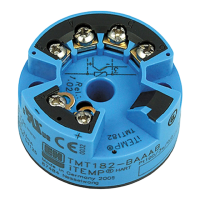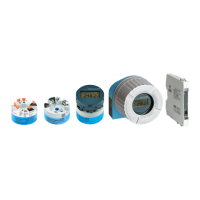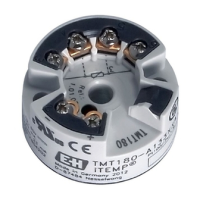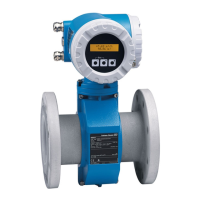Safety function Temperature transmitter iTEMP TMT82
10 Endress+Hauser
4 Safety function
4.1 Definition of the safety function
The device's safety function is:
Safe measurement → 10
4.1.1 Safety-related output signal
The device's safety-related signal is the analog output signal 4 to 20 mA as per NAMUR
NE43. All safety measures refer to this signal exclusively. In addition, the device also
communicates via HART® for information purposes and comprises all the HART® features
with additional device information. HART® communication is not part of the safety
function.
The safety-related output signal is fed to a downstream logic unit, e.g. a programmable
logic controller or a limit signal transmitter where it is monitored for the following:
• Overshooting and/or undershooting of a specified limit value
• The occurrence of a fault: e.g. failure current (≤ 3.6 mA, ≥ 21.0 mA, signal cable open
circuit or short-circuit)
In the SIL mode, the transmitter cannot be configured for inverse value display at the
current output.
In the event of a fault, it must be ensured that the equipment under control achieves
or maintains a safe state. See "Structure of the measuring system" section → 32
4.1.2 Safe measurement
The transmitter's safety function comprises a transmitted current output signal
proportional to the voltage, resistance or temperature value.
The safety function can be used with all sensor configurations from the "Structure of the
measuring system" section→ 32. Note here that only the measured value of one
sensor or the value of a function (e.g. the mean value of or difference between the two
measured values) can ever be displayed via the current output.
4.2 Basic conditions for use in safety-related applications
The measuring system must be used correctly for the specific application, taking into
account the medium properties and ambient conditions. Carefully follow instructions
pertaining to critical process situations and installation conditions from the Operating
Instructions. The application-specific limits must be observed. The specifications in the
Operating Instructions and the Technical Information must not be exceeded.
• Information on the safety-related signal. → 10
• Compliance with the specifications in the Operating Instructions is mandatory. → 8
• The ambient temperature of the device is –40 to +70 °C (–40 to +158 °F)
• Compliance with the ambient conditions as per IEC 61326-3-2 Appendix B is
mandatory.
• The head transmitter must not be operated as a DIN rail substitute in a cabinet by using
the DIN rail clip with remote sensors.
• Use of the FXA291 and TXU10 communication interface is not possible in the expert
mode (only via HART® communication).
• The device may only be powered by a power unit with an energy-limited circuit in
accordance with UL/EN/IEC 61010-1, Section 9.4 and the requirements of Table 18.
• Configure the mains frequency filter correctly (50 Hz/60 Hz).
• The fault response time must meet the safety requirements.
• Maximum permitted sensor cable resistance for voltage measurement: 1 000 Ω.
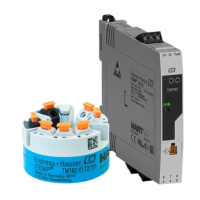
